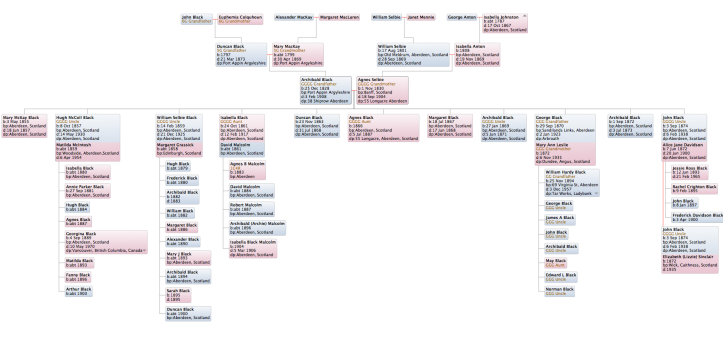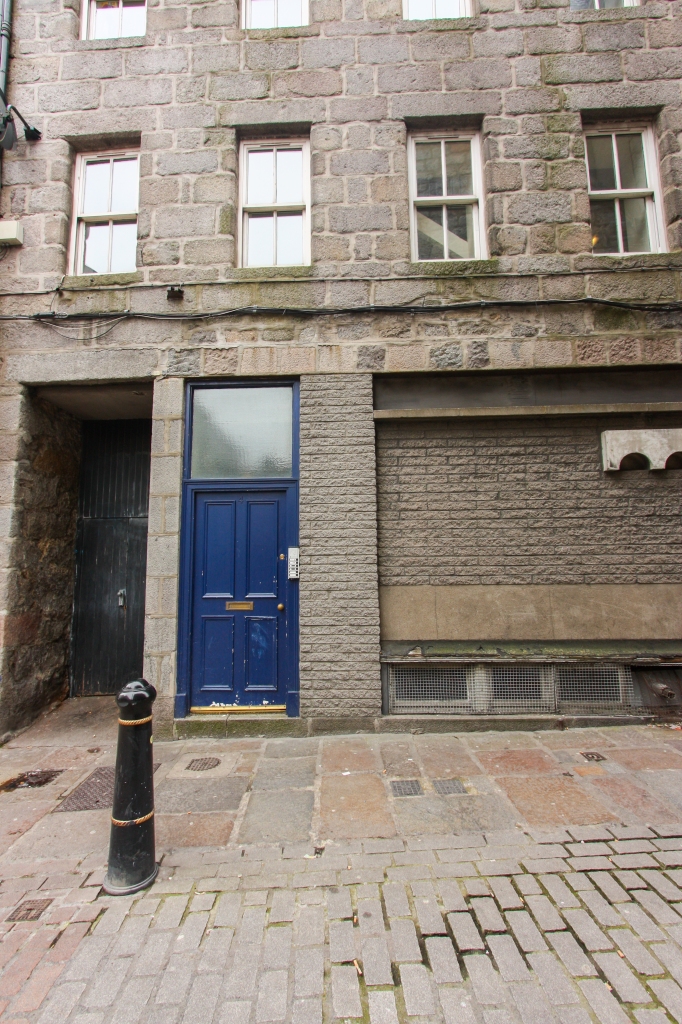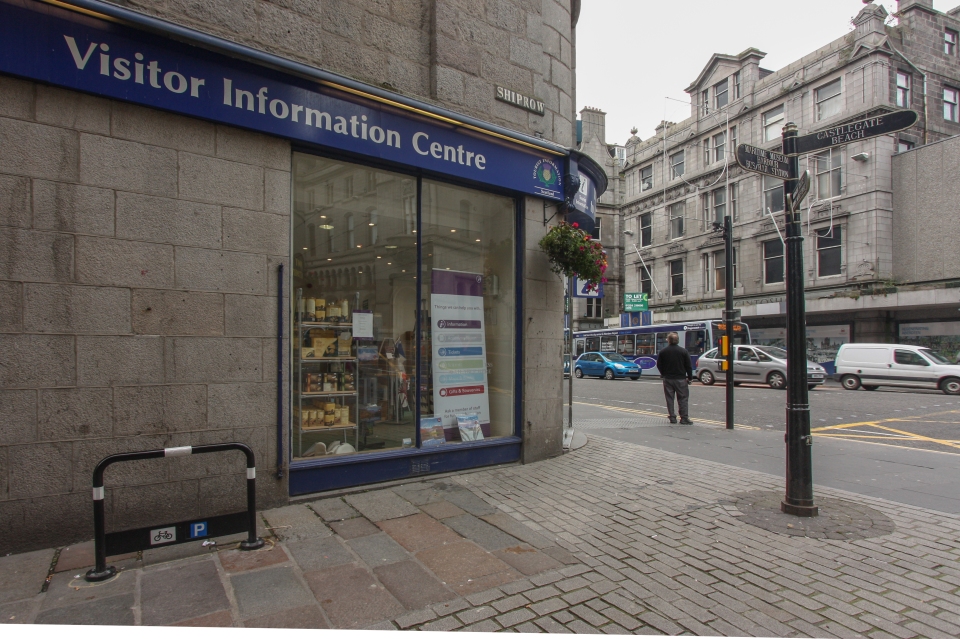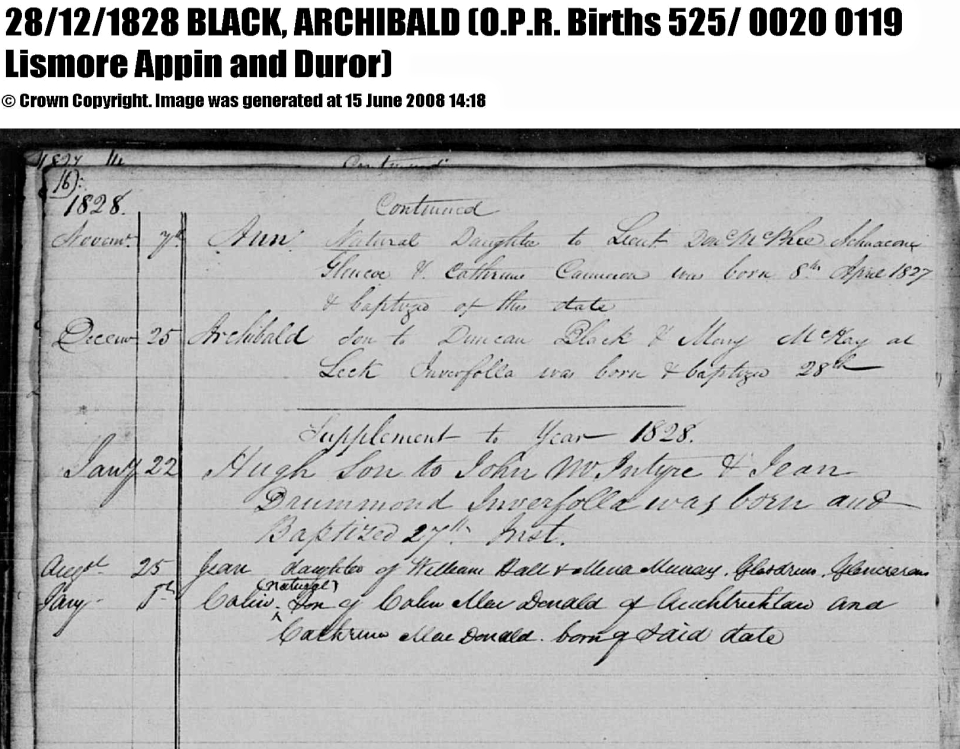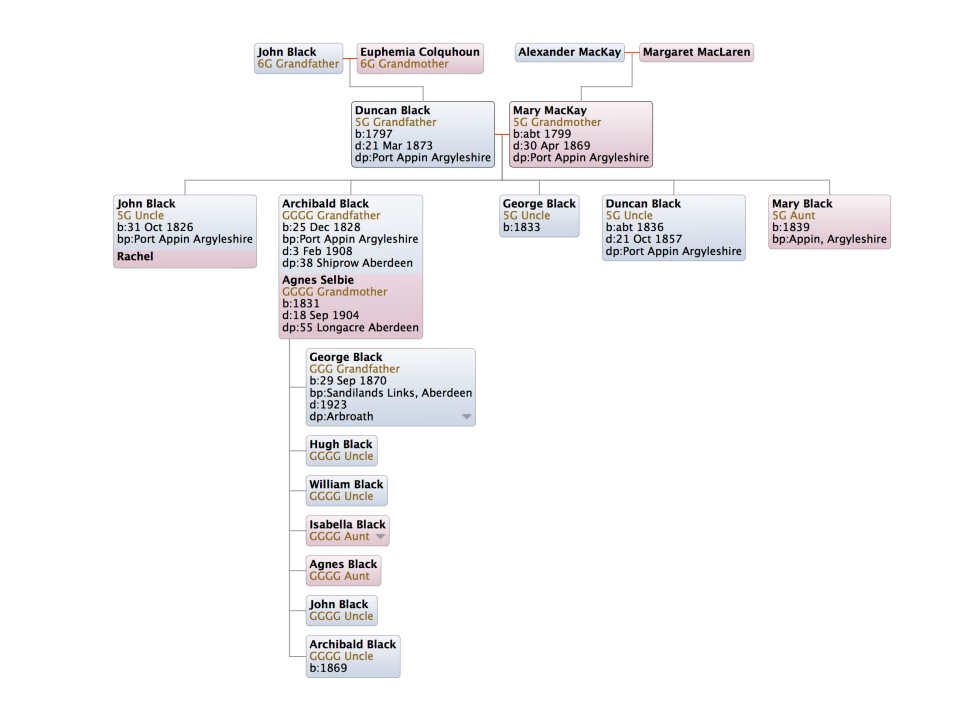In my earlier post on the family of Duncan Black and Mary McKay, I was unable to provide a complete description of their family as I was not able to identify the whereabouts of their son, George Black. I have since found George and now have the details of his family and descendants for two further generations. George also migrated to Aberdeen from Port Appin, following his brother Archibald.
I located George in the 1861 census, living in Archibald’s home in Aberdeen at 12 Yeats Lane, working as a labourer at a chemical works, possibly the same workplace as Archibald. 1861 was also the year George married, on 5th July, to Christina (her name is also given as Christian) Thomson, a native of Aberdeen and a woollen mill worker.
Christina’s father John Thomson was a farmer and the family appear to have lived for a while in Banchory, about 18 miles west of Aberdeen. Two of Christina’s elder siblings, John and Isabella, were born in Banchory, although her parents were married in Aberdeen. By the time of Christina’s birth in 1836, the family was living in Aberdeen. Christina’s mother was Elspet or Elsie Falconer, born about 1800. She supported the family for many years after the death of her husband and was living with Christina and son-in-law George when she died in 1875.
George Black and Christina Thomson lived initially at 2 Windy Wynd and later at 184 Gallowgate, Aberdeen. They had eight children at these addresses:
- George, born 10th January 1862
- Isabella, born 13th October 1863
- Christina, born 22nd June 1865, died 26th April 1870
- Mary, born 10th September 1867
- John, born 27th September 1869, died 6th December 1870
- Elsie Falconer, born 16th March 1872 (named after her maternal grandmother)
- Margaret (Maggie), born 6th January 1874
- John, born 18th May 1876.
Christina lived to the age of 70 in 1906. The information on her death certificate was provided by her daughter Elsie Rippon, nee Black.
George died in 1918, at the age of 85, at his daughter Margaret Ingram’s house in Ashvale Place, Aberdeen. He died on 13th April. The day before on the 12th, one of his grandsons, Lawrence Rippon, was killed in action in France, fighting with the Royal Scots 2nd Battalion.
Of George and Christina’s children, all married and had families, except for Christina and the first John who both died young.
- George, a plumber, married Catherine Skakle Mitchell from Cullen in Banffshire in 1887 and they had four children, all living in Aberdeen.
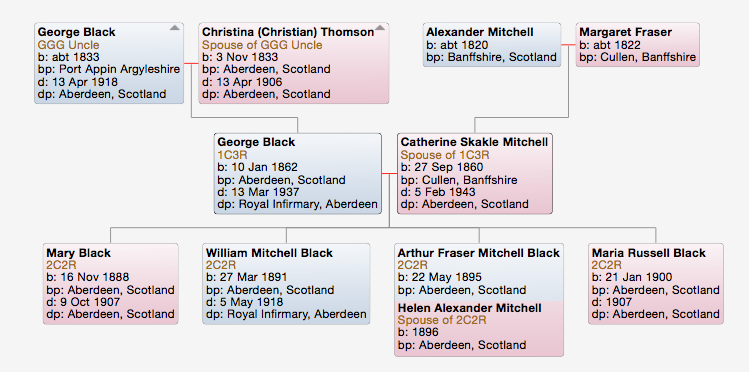
Family of George Black (1862 – 1937) and Catherine Mitchell (1860 – 1943)
- Isabella, a flax mill worker, married William Beattie Duncan, a gardener, in 1882. They moved to Ayr in Ayrshire where the youngest of their three sons, John, was born.
- John, a telegraph messenger in the post office, joined up as a rifleman in the London Regiment (Post Office Rifles) 1st/8th Battalion in World War 1. He was killed in action on 15 September 1916 in France. He has no known grave but his name is commemorated on the Thiepval Memorial, the memorial to the Missing of the Somme, near the French village of Thiepval.
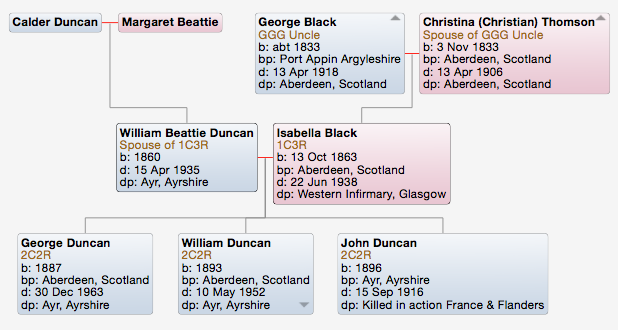
Family of Isabella Black (1863 – 1938) and William Duncan (1860 – 1935)
- Mary, a cotton mill worker, married Edward Masson, a stone polisher at the granite works, in 1889. At the 1911 census she reported that she had had 10 children born alive, of which four were still living. She and her husband migrated to Canada in 1921, following her eldest surviving daughter Margaret there, and settled in Winnipeg, Manitoba.

Family of Mary Black (1867 – 1934 and Edward Masson (1863 – 1936): four surviving children
- Elsie, a cotton spinner, married Ernest John Rippon, a French polisher from Callington in Cornwall, England, in 1892. They were living in Beith, Ayrshire at the time of their third child’s birth in 1896, but when Ernest died in 1904, the family returned to Aberdeen. Elsie remarried in 1906 to John Jeffrey, a widower with six children, and continued to live in Aberdeen.
- Elsie and Ernest’s second child, Lawrence, initially enlisted on 30th November 1914 in the Cheshire Regiment 16th Service Battalion but was discharged in February 1915 because of flat feet. However he re-enlisted in May 1915 in the 17th Royal Scots. He was killed in action in France/Flanders on 12 April 1918. He has no known grave but is memorialised on the Ploegsteert memorial, south of Ieper (Ypres) in Belgium.
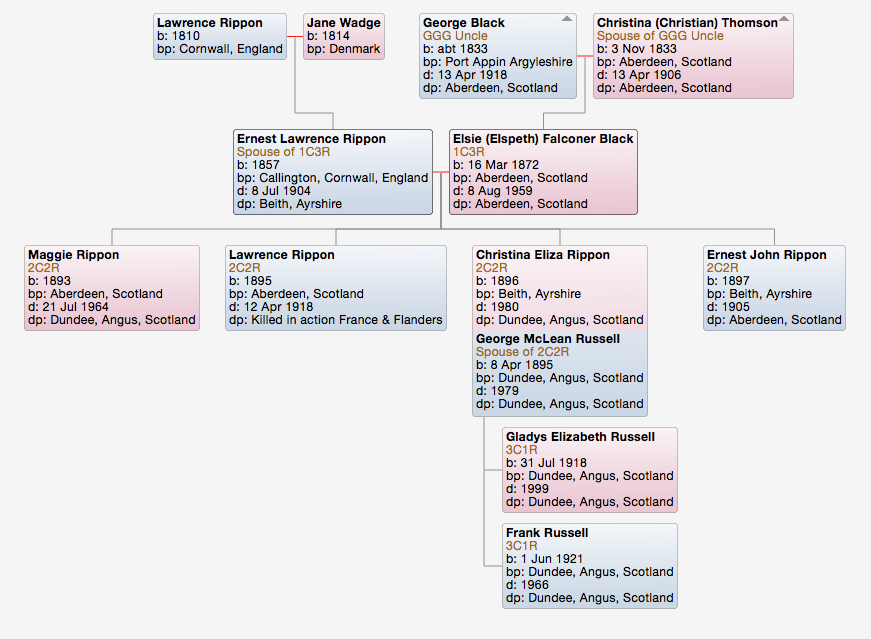
Family of Elsie Falconer Black (1872 – 1959) and Ernest Lawrence Rippon (1857 – 1904)
- Margaret (Maggie) married Charles Ingram, a coach finisher in the coach building industry and tramway car repairer (once also described as a blacksmith’s viceman) in 1897. Maggie also worked as a cotton spinner. They had a family of three sons and one daughter, another Maggie, all born in Aberdeen. Charles Ingram’s mother was a Rippon from Callington in Cornwall and appears to have been a cousin of the father of Elsie’s husband, Ernest Rippon.
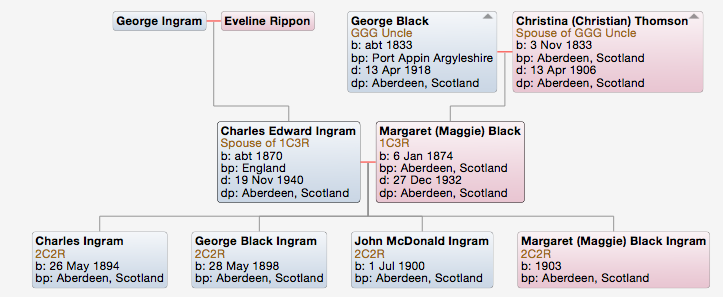
Family of Maggie Black (1874 – 1932) and Charles Ingram (1870 – 1940)
- John, an iron moulder, married Isabella Cochrane from Aberdeen in Beith, Ayrshire in 1900. They had a family of five children, born in Scotland and England. They were living in Aberdeen at the birth of their last children in 1910 who were twins, but one child lived only nine days. They migrated to Toronto in Canada in 1921, where their eldest son George also lived.
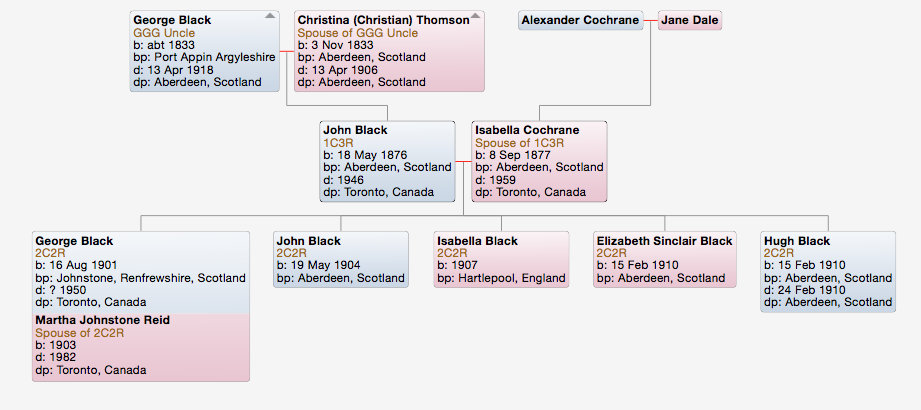
Family of John Black (1876 – 1946) and Isabella Cochrane (1877 – 1959)
So George’s branch of the Black family became fairly firmly established in Aberdeen, with some later generations attracted to migration to Canada.
Between them, Archibald and George Black had 19 children and 59 grandchildren. It’s just as well they left Port Appin for the larger metropolis.

